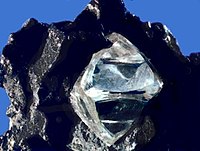
Photo from wikipedia
Abstract In this work, the x-ray induced luminescence technique was used to investigate natural and imitation rubies. The red and pink natural rubies in the present work were provided from… Click to show full abstract
Abstract In this work, the x-ray induced luminescence technique was used to investigate natural and imitation rubies. The red and pink natural rubies in the present work were provided from Myanmar and Vietnam, respectively. The imitation rubies (red and pink glasses) in glass were taken from imitation jewelry company in Thailand. Optical, compositional and structural were studies to confirm the identification of natural and imitation stone. X-ray diffraction (XRD) study reveals that natural rubies contain α-Al2O3 as the major phase. On the other hand, XRD does not show sharp peak for imitation ruby stone, therefore it indicates that the imitation rubies are made of amorphous material (glass). Absorption spectra in visible region of natural rubies, red and pink glasses show a prominent absorption band around 520–560 nm wavelength with Cr3+ transitions, gold nanoparticles and Er3+ transitions, respectively. Photoluminescence (PL) emission spectra of both natural rubies show strong red emission at 692 nm (λex = 577 nm), relating to Cr3+ transition (2Eg→4A2g). The green emission peak at 548 nm (λex = 403 nm) of imitation ruby (pink glass) was observed; it comes from the transition of Er3+ (4S3/2 → 4I15/2). The x-ray induced luminescence (XIL) spectra of natural rubies show similar pattern with PL result, while XIL of imitation rubies cannot be observed. This XIL result show the fast separation behavior between natural and imitation rubies. Therefore, XIL is suitable for using as a luminescence analysis of gemstones because of their fast process, non-destructiveness and without excitation wavelength special sample-preparation needs.
Journal Title: Radiation Physics and Chemistry
Year Published: 2020
Link to full text (if available)
Share on Social Media: Sign Up to like & get
recommendations!